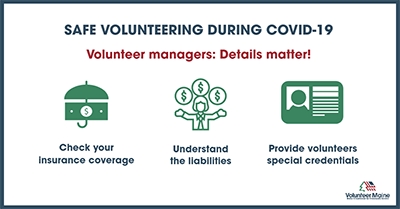Volunteer managers in Maine already have a lot to juggle, but a worldwide pandemic has created a new set of challenges that need to be dealt with immediately. Agencies that provide food, shelter and/or support services now have to quickly prop up plans to continue serving in a safe manner, and in some cases, how to safely expand capacity.
With so much new to think about, and with it being National Volunteer Week, we at Volunteer Maine have pulled together a three-part series featuring tips and resources to help volunteer managers navigate the COVID-19 outbreak. We hope this information is helpful, and we would like to extend a huge thank you to those going above and beyond – such as the volunteers, managers and board members –to help Mainers in need.
Part 2: How can local agencies adapt to provide safe volunteering opportunities?

Local agencies, in Maine and beyond, have had to find new and creative ways to make sure community members are still being served. Of course, this idea of adapting can be quite a challenge for volunteer managers. Between being mindful of resources and keeping up with ever-changing safety guidelines, there's lots more to think about.
We at Volunteer Maine have been working with National Service programs, emergency agencies, and local providers to help them adapt so they can continue serving. Here are a few basics to think about.
Establish safety as the number one priority: To ensure a safe volunteering environment, managers of volunteers need to follow the guidance set at both the state and federal level. So if the agency is not deemed essential, you should not be welcoming on-site volunteers until given the all clear. From social distancing, to following stay-at-home-orders, to practicing ultra-good hygiene, the safety of volunteers and recipients of service needs to be the top priority.
Embrace technology: Here's a throwback, especially for the comic book aficionados in the audience: Remember Dick Tracy? We're not talking the 1990 movie adaptation, either! For those who aren't familiar with the rough-and-tumble yet cunning detective, his gadgets were actually quite ahead of the times. He famously wore a two-way walkie-talkie wrist watch, which first appeared in the comic strip in the mid-40s. In the 60s, the walkie talkie function was upgraded to the two-way wrist TV. At the time, these devices seemed like magic from a far-off universe, but wait a minute! Here in 2020, we have that exact same technology in smart watches. Now you may be wondering what the heck this all has to do with embracing technology. Here's the takeaway: Technology can make the seemingly impossible possible. If you're feeling overwhelmed about how to continue service, try this approach: Think about the purpose of the services you are trying to offer and brainstorm ways they can be offered digitally. Sure, some efforts won't translate, but you may be shocked to find how many can, thanks to technology - keep reading for some examples!
Don't lose sight of your goals: We realize that's a tough ask, but it's a critical one. Why? Like we touched on in the tech section, keeping your eyes on the prize can inspire a whole new type of service delivery. In Maine, we've seen educational programs for youth at-risk pivot to provide safe deliveries of healthy meals as a way make sure the families they normally serve remain fed. Phone reassurance programs, both traditional calls and video chats, are a popular alternative for agencies providing mentorship, support services to families, or companionship to a member of Maine's senior community.
Just because an agency is not deemed essential does not mean service has to stop. With a little bit of guidance, technology and creativity, volunteer managers can keep community-based services going. Points of Light, the organization that brings you Service Enterprise training, has plenty of helpful resources available to help agency managers remain on track. Check them out below!
COVID-19 Volunteer management resources from Points of Light
"Starting a virtual volunteer program" - read here
"Additional safety tips for volunteering in a COVID-19 world" - read here
"Service project ideas for kids and teens" - read here
"Employee volunteering when you can't serve in person" - read here
What's next?
The third part in our three-part series of tips focuses on some extra details that could be overlooked. Access the post here. If you haven't done so yet, check out post one, which focuses on the difference between essential volunteering and local efforts -- access here.